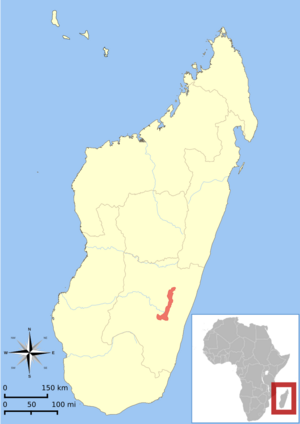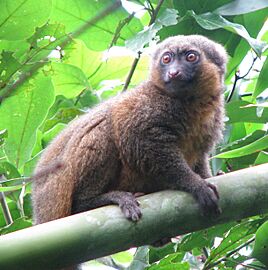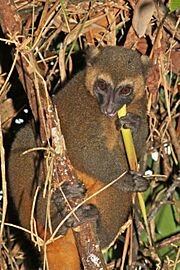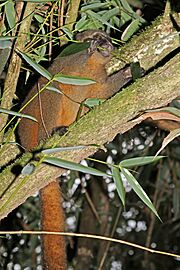Golden bamboo lemur facts for kids
Quick facts for kids Golden bamboo lemur |
|
|---|---|
 |
|
| In Ranomafana National Park | |
| Conservation status | |
| Scientific classification | |
 |
|
| Distribution of H. aureus |
The golden bamboo lemur (Hapalemur aureus) is a special type of bamboo lemur. It is found only in the rainforests of south-eastern Madagascar. Local people in Madagascar call it bokombolomena or varibolomena. This medium-sized lemur is famous for its unique diet.
One amazing fact about this lemur is its ability to eat bamboo shoots that contain cyanide. It can handle twelve times more cyanide than other animals of its size. This makes it very special!
Contents
Meet the Golden Bamboo Lemur
The golden bamboo lemur is about the size of a house cat. It grows to be about 28 to 45 centimeters (11 to 18 inches) long. Its tail adds another 24 to 40 centimeters (9 to 16 inches) to its length. On average, these lemurs weigh about 1.6 kilograms (3.5 pounds).
These lemurs are most active during dawn and dusk. This type of activity is called crepuscular.
Where Golden Bamboo Lemurs Live
The golden bamboo lemur lives only in the rainforests of south-eastern Madagascar. They are found at high elevations, from about 600 to 1400 meters (2,000 to 4,600 feet) above sea level.
They were first discovered in 1986 by a scientist named Dr. Patricia Wright. This discovery happened near what is now Ranomafana National Park. Later, in 1993, they were also found in Andringitra National Park. Scientists believe they might live in a forest area that connects these two parks.
What Golden Bamboo Lemurs Eat
As their name suggests, golden bamboo lemurs mostly eat bamboo. They especially love a type of giant bamboo called volohosy (Cathariostachys madagascariensis). They munch on new shoots, the bases of leaves, and the climbing parts of the bamboo.
The young shoots of this bamboo contain a small amount of cyanide. Each adult lemur eats about 500 grams (1.1 pounds) of bamboo every day. This amount of bamboo contains about twelve times the amount of cyanide that would be deadly for most other animals of the same size. Scientists are still studying how these lemurs can safely eat so much cyanide.
Golden Bamboo Lemur Life Cycle
Golden bamboo lemurs live in small family groups. These groups usually have two to six individuals. They roam around an area of up to 80 hectares (200 acres). However, they usually travel less than 400 meters (1,300 feet) in a single day.
Female lemurs are pregnant for about 138 days. They usually give birth to one baby, but sometimes they have two. Births happen at the start of the rainy season, in November or December. Young lemurs rely heavily on their mothers. For their first two weeks, they are kept hidden in thick plants to stay safe.
Protecting the Golden Bamboo Lemur
The golden bamboo lemur was first discovered in 1986 by Dr. Patricia Wright. This discovery led to the creation of Ranomafana National Park in 1991. The park was set up to protect this endangered lemur and many other unique animals and plants.
Sadly, the number of golden bamboo lemurs is decreasing. There are only about 1,000 individuals left. The main reasons for this decline are hunting and the loss of their forest home. People cut down forests using a method called slash-and-burn agriculture. They also cut down bamboo for building materials, carrying water, and making baskets.
Because of these threats, the golden bamboo lemur is listed as critically endangered. This classification comes from the International Union for Conservation of Nature (IUCN). It is also protected under Appendix I of CITES. CITES is an international agreement that helps control the trade of endangered animals and plants.





